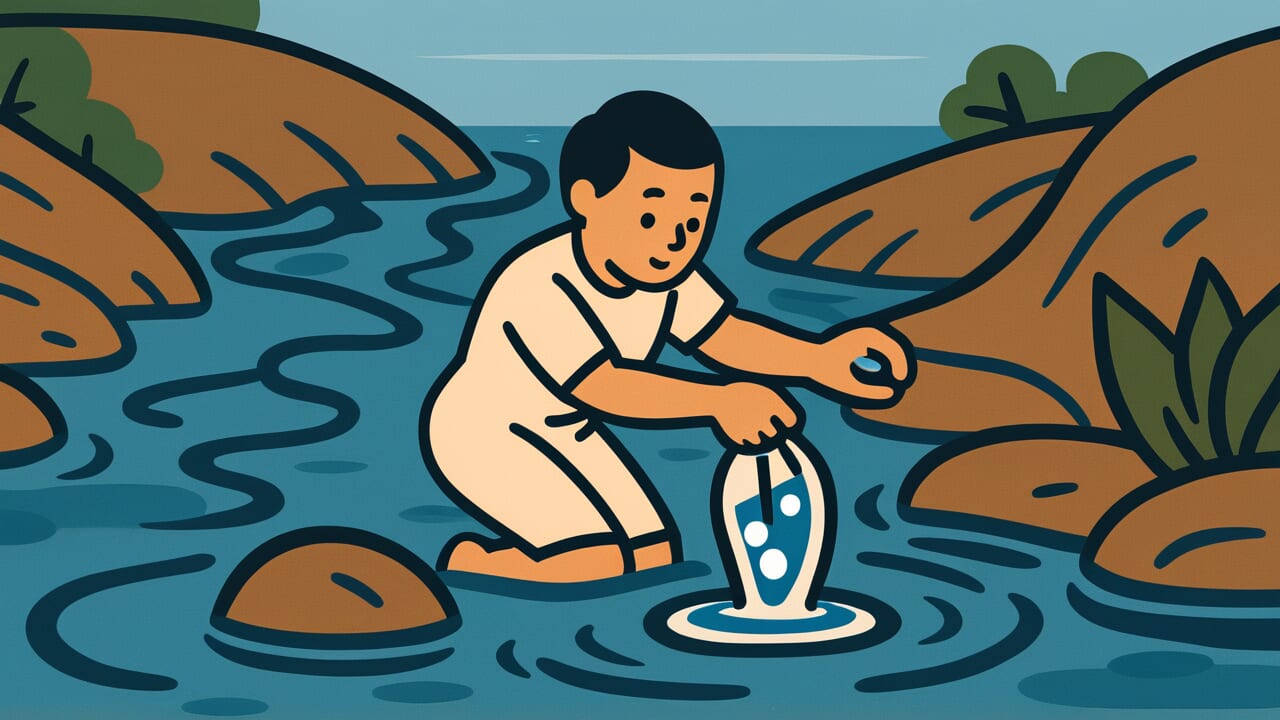How to Read “Draw the water to know the source”
Nagare wo kumite minamoto wo shiru
Meaning of “Draw the water to know the source”
“Draw the water to know the source” means you can understand the cause or essence of something by carefully observing the results you see before you.
Just as drawing water downstream tells you about the source upstream, analyzing what appears on the surface helps you understand the hidden root causes.
This proverb is used when solving problems or analyzing situations. It describes the attitude of looking beyond surface phenomena to find the fundamental causes when problems arise.
Even today, this saying guides us in business and relationships. It reminds us how important insight is for seeing essential problems behind visible results.
Origin and Etymology
The exact origin of this proverb has several theories, but it likely shows influence from classical Chinese thought.
The contrasting concepts of “flow” and “source” have long been important metaphors in Eastern philosophy for exploring cause and effect.
The phrase structure is interesting. It uses “draw” rather than simply “see” the flow. This is an active verb that describes physically taking water in your hands to examine it.
By drawing water downstream and checking its quality, temperature, and contents, you can guess the condition of the source upstream. This practical wisdom is embedded in the saying.
The choice of water flow as the subject is also significant. Water flows from high places to low places, carrying various information along the way.
Ancient people observed river water to guess upstream weather, geology, and even how people lived there. Such real-life experiences gradually became an abstract way of thinking about finding causes from results.
Usage Examples
- Looking at his attitude now, you can draw the water to know the source and imagine what happened in his past
- From the company’s declining performance, we drew the water to know the source and searched for problems in our management policies
Universal Wisdom
“Draw the water to know the source” has been passed down for generations because it connects to our fundamental human desire to know and our wish to see what cannot be seen.
In daily life, we constantly face results. Someone’s angry expression, a company’s declining sales, a child’s changing grades. But these are just the tip of the iceberg.
What truly matters is understanding the cause that produced those results—the “source.” Without understanding the source, the same problems will repeat themselves.
This proverb shows trust in human reasoning and observation abilities. Even with limited information, we can approach truth through careful observation and repeated consideration.
This ability is the foundation on which humanity has built civilization and maintained complex societies.
At the same time, this proverb teaches humility. To know the source, you must first carefully draw the flow.
Rather than rushing to conclusions, you need patience to observe phenomena closely. Our ancestors continue teaching us to avoid shallow judgments based only on surfaces and to value deep thinking.
When AI Hears This
As river water flows from upstream to downstream, tributaries merge, rainwater mixes, and sediment dissolves. Information keeps adding and becoming more complex.
This is exactly entropy increase in information theory. Entropy means “messiness level.” Like milk mixing into coffee and never separating again, information mixes over time and becomes indistinguishable.
Yet we try to guess the clear upstream source by looking at muddy downstream water. This is remarkable intellectual work because we’re trying to restore lost information.
Criminal investigation works the same way. The crime scene as “flow” contains countless mixed pieces of information, but investigators extract only essential patterns to reach the “source”—the true criminal.
What’s interesting is that complete restoration is impossible. Information theory proves you cannot 100 percent reproduce the original state after entropy increases.
So when we think we “know the source” from the “flow,” we’re actually just building the most statistically reasonable hypothesis.
The essence of this proverb isn’t impossible complete restoration but compression technology that sees essence from limited information. AI finding laws from big data is exactly this “reverse analysis.”
Lessons for Today
Modern society overflows with information. We constantly swim in a whirlpool of results and phenomena.
Someone’s social media post, workplace problems, family changes. But the spirit of “draw the water to know the source” matters precisely because of our times.
This proverb teaches us the danger of superficial judgment. When someone is angry, don’t just see the anger—think about what created that emotion.
When performance drops, don’t just blame the numbers—search for structural problems behind them. Such attitudes open the path to real solutions.
What you can do is first pause. Instead of reacting reflexively to phenomena before you, step back and take time to observe.
Then ask yourself: “Why did this happen?” “What is this result teaching me?” Those questions become signposts leading to the source.
The habit of thinking deeply will make your life richer and more meaningful.



Comments